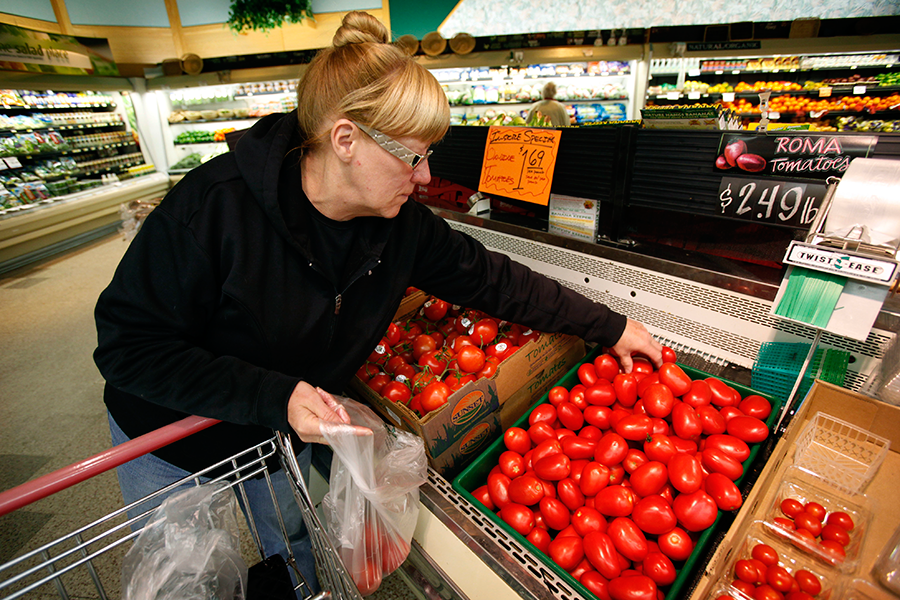Tired of tasteless grocery store tomatoes? Scientists are on it.
Loading...
The taste has been bred out of grocery store tomatoes over the course of decades. But within a few years, scientists may have put much of it back – with a little help from genetic sequencing.
Researchers at the University of Florida may know what’s wrong with modern tomatoes, a study published Thursday in the journal Science revealed. By comparing the genetic makeup and flavor profile of ancestral and heirloom varieties with commercially available tomatoes, the scientists were able to identify specific chemical compounds that made tomatoes more delicious.
Now that they know what the tomatoes are missing, the researchers are working to restore the lost attributes, primarily by crossbreeding with heirloom varieties. Though the commercial need for large, sturdy tomatoes means that not all their taste can be restored, a much-improved tomato could hit supermarket shelves within three years.
“If those tomatoes can be even slightly improved it will be a big gain for consumers, and this study certainly shows a road map of how that can be done,” Esther van der Knaap, a plant geneticist at the University of Georgia who was not involved in the study, told Smithsonian Magazine.
Tomatoes have been cultivated for more than two millenniums, according to Science Magazine. Though new varieties developed and others disappeared over that time, the fruit remained small and sweet. But with the advent of commercial agriculture following World War II, size and sturdiness became paramount. Large fruit were more cost-effective for growers paid by the pound, and strong tomatoes shipped better than softer ones.
At first, no one really noticed the trade-off: a decline in the tomatoes’ flavor. But over time, the difference became apparent.
Good heirloom tomatoes “are like eating candy,” Marion Nestle, a nutrition professor at New York University who was not involved in the study, told the Associated Press. Sugar provides much of a tomato’s taste. With bigger tomatoes, the limited amount of sugar produced by a plant is shared with more fruit, weakening the flavor.
There wasn’t much the researchers could do to change that, University of Florida horticultural scientist and study co-author Harry Klee told the AP. So they turned their attention to the other component of taste: smell.
They started by sequencing the genomes of almost 400 tomato varieties, including commercial and heirloom varieties. They then performed taste tests on 101 of these tomatoes, recording which ones people preferred. Looking at the chemical makeup of the favored tomatoes, they found 25 chemical compounds, known as volatiles.
“The real excitement of food is what you smell,” Denise Tieman, a research assistant professor at the University of Florida and the first author of the paper, told The Los Angeles Times. “When you chew, these aroma compounds get into your olfactory systems and that’s what really makes things taste good.”
In commercial tomatoes, 13 of those compounds are significantly reduced, Dr. Klee told Smithsonian Magazine. The loss of these compounds was not necessarily intentional, he said: Without genetic testing, it’s hard to tell when a chemical drops out of the gene pool until so many disappear that flavor begins to be affected.
The researchers have begun a quest to reintroduce the genes for these chemical compounds into commercial tomatoes. By crossbreeding these tomatoes with heirloom varieties, Klee and his fellow researchers expect to produce a large, sturdy, and delicious tomato within a few years.
“The right mix of volatiles can give the perception of sweetness without sacrificing fruit size or yield,” Science Magazine concluded.
Of course, such an advance often comes with tradeoffs. The tomatoes may have a slightly shorter shelf life, and plants may be only about 90 percent as productive as they are now. These factors will likely increase the cost of tomatoes. But consumers may be willing to pay for a better product, Klee told Smithsonian Magazine, pointing to the taste premium on craft beers and coffee.
And the technique could be used to enhance flavor in other supermarket fruits and vegetables. In fact, a commercial strawberry breeder has hired some of Klee’s former students to do just that, he told the L.A. Times.
“The strawberry breeder can’t use the same genes we are using, but what they can do is apply the same approaches,” Klee said.
Material from the Associated Press contributed to this report.






